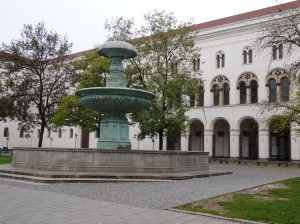A report on WPMSIIP 2015
Posted on November 6, 2015 by Christoph Jansen and Julia Plass[ go back to blog ]
The 8th Workshop on Principles and Methods of Statistical Inference with Interval Probability, organized by the working group “Foundations of Statistics and Their Applications” of the Department of Statistics and the “Munich Center for Mathematical Philosophy (MCMP)” of the Department of Philosophy from the LMU Munich took place from the 1st to the 6th of September 2015 (actually we ended at the 5th, because unfortunately our excursion was cancelled because of bad weather forecast…).

In the old WPMSIIP tradition, on every day there were contributions ranging from well-structured presentations to spontaneous discussions of questions. Further, we completed every day with a visit in some nice restaurant (including “Prinz Myshkin”, Frank’s favourite).
On Tuesday it was Philosophers’ day, who discussed the phenomenon of dilation. First Seamus Bradley from the MCMP motivated the topic and gave an introduction to “Dilation and the value of information”. Afterwards, Gregory Wheeler and Arthur Paul Pedersen gave some deeper insights by interactively presenting some new ideas from the field. After lunch, it was discussion time. Here, the discussion (which was masterfully moderated by Greg Wheeler and Paul Pedersen) ranged from hot topics like “examples for non-convex sets of probabilities beyond coin-flipping” to more general considerations such as the role of imprecise probabilities in statistics.

On Wednesday, we turned to some more statistical stuff: Imprecise observations. Firstly, Julia Plass gave a presentation on “Statistical modelling under epistemic data imprecision” and discussed some open questions with the audience. Subsequently, Paul Fink introduced us into the art of playing darts: In his talk he proposed a way to generalize the (illustration of the) NPI model to coarse data by using a dartboard instead of a probability wheel. This was followed by a lively discussion. In the afternoon, Georg “Giorgio” Schollmeyer talked about structural properties of the rounding mapping and some implications for location measures. To complete the formal part of the day, we heard some new ideas about “MLE-equivalence and Coarse Data in Generalized Linear Models” by Thomas Augustin, who intends (as a main goal) to generalize the concepts of sufficiency to an IP-based treatment of coarse data.
On Thursday, it was Open Topics Day. Paolo Vicig started with a very welcome tutorial talk on “2-coherent and 2-convex Lower Previsions”, which included a detailed version of his ISIPTA ‘15 contribution. Afterwards, Thomas Augustin linked to his WPMSIIP 2014 contribution in Ghent by presenting proposals for solutions for questions that arised in the earlier talk. After having solved his “dog problem” (those who were there will know exactly what we’re talking about), Paul Pedersen joined the group after lunch with a spontaneous presentation about “Strictly coherent choice”. In the end of the day, Christoph Jansen considered some connections between “Gamma-maximin and least favourable prior distributions”.
Friday was reserved for Graphical Models. The first talk was jointly given by Barbara Osimani and Roland Poellinger who addressed some applications in the field of “Nesting Causal Models and Evidential Relations”. Again the talk was accompanied by exciting discussions. Next, it was Eva Endres’ turn. Her talk was about “Probabilistic Graphical Models for Statistical Matching” with a focus on discussing some interesting new questions of how to combine (imprecise) probabilistic graphical models with methods of statistical matching. To round the (academic part of the) day off, Jasper de Bock enthusiastically recalled some concepts of independence for graphical models under the light of sensitivity analysis.
The week ended with a section on Risk and Reliability. Gero Walter presented some open questions from his research on system reliability (revisiting and extending his ISIPTA ‘15 contribution) causing some really productive and helpful discussion with the audience. After that there was a joint presentation given by Jasper de Bock, Thomas Krak and Stavros Lopatatzidis. They intensively made use of the blackboard for giving insights to the theory of Imprecise continous time Markov Chains with a discrete state space, which ranged from theoretical aspects to computational issues. The afternoon was organized by Ulrika Sahlin. The topic of interest was Evidence-based Decision Theory and in particular how to reflect low evidence via imprecision in the result.
Our impression on WPMSIIP 2015: The worky-shoppy ratio was close to (or even larger than) one. A lot of nice presentations were given and interesting ideas were exchangend. Organizing the workshop was real fun and thus we can only suggest this job to everyone!
If you wish to do so, please contact Frank Coolen.
See you there (wherever that will be…)!
